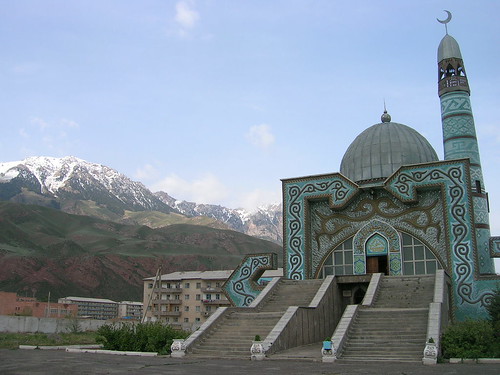Qadiriyya & Naqshbandiyya in Kyrgyzstan

Mosque at Naryn, Kyrgyzstan
The Kyrgyz are Sunni Muslims of the Hanafi school of law, but the degree to which the north and south adhere to religious practices must be considered when understanding the role of Islam in Kyrgyzstan. The distinction is often made between the religious practices of Islam and the everyday cultural practices of Islam. Islamic mosques and madrassah were built by the sixteenth century in the southern regions of Kyrgyzstan. One of the most important holy places for Muslims in Kyrgyzstan is the Throne of Suleyman in the southern city of Osh. It is sometimes referred to by Soviet Muslims as the "second Mecca." By contrast, Islam infiltrated northern Kyrgyzstan in a slower, less encompassing manner. Many ancient indigenous beliefs and practices, including shamanism and totemism, coexisted syncretically with Islam. This split between the northern and southern Kyrgyz in their religious adherence to Muslim practices can still be seen today. Likewise, the Sufi order of Islam has been one of the most active Muslim groups in Kyrgyzstan for over a century.
The four Sufi tariqas (paths to God, or Sufi brotherhoods) that brought Islam to the Kyrgyz and remain in Kyrgyzstan are: the Naqshbandiya, which is Bukharan and very popular and powerful; the Qadiriya, an ancient tariqa; the Yasawiya, a south Kazakhstan tariqa; and the Kubrawiya, a Khorezm tariqa. In addition, there are two newer indigenous orders that sprang from the Yasawiya. The earlier of the two is the Order of Lachi, which formed in the late nineteenth century. It opposed the older orders and was oppressed by them in return. As a result of this enmity, the Lachi initially supported the Bolsheviks but later came to oppose them. The Lachi went underground, and the Soviets could not find them again until the 1950s. Several villages in the Osh Oblast are composed entirely of Lachi members. Another indigenous Sufi order is the Order of the Hairy Ishans, which formed in the 1920s and was intensely anti-Soviet. As a result of its opposition, the Soviets attacked them in 1935-1936 and again in 1952-1953, killing some of their leaders. The Hairy Ishan order, unlike other Sufi orders, allows women to participate in the zikr (prayers) and to form their own female-only subgroups. On the whole, however, under the Soviets the practice of Sufism became highly secretive, even to the point that the silent zikr has replaced the zikr said aloud.
Under the Soviets, religious activity and belief were strongly discouraged, although not eradicated. The Soviets printed anti-Islamic books for Kyrgyz consumption (sixty-nine titles between 1948 and 1975) and gave antireligious lectures (45,000 in Kirghizia in 1975 alone). Antireligious propaganda was seen or heard in the opera, the ballet, the theater, and over the radio. The Soviets also formed motor clubs, whose task it was to bring antireligious propaganda to isolated regions. Reforms in the 1980s made open religious observance possible for the first time in many decades. A significant number of Kyrgyz observe Muslim practices in their everyday lives but not in a religious sense. Kyrgyz women do not wear veils, nor do they avoid men to whom they are not related.


0 Comments:
Post a Comment
<< Home